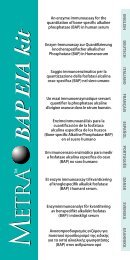Clinical and Technical Review - Tecomedical
Clinical and Technical Review - Tecomedical
Clinical and Technical Review - Tecomedical
You also want an ePaper? Increase the reach of your titles
YUMPU automatically turns print PDFs into web optimized ePapers that Google loves.
4<br />
Bone Formation<br />
Osteoblast:<br />
The osteoblast is the bone cell responsible for:<br />
1) The formation <strong>and</strong> organization of the extracellular matrix<br />
(ECM) of bone <strong>and</strong> its subsequent mineralization;<br />
2) Synthesis of collagen <strong>and</strong> other bone proteins. Three<br />
periods are distinguished in the osteoblast life cycle.<br />
A) Cell proliferation: genes associated with formation of the<br />
ECM, like Type I Collagen, are expressed <strong>and</strong> gradually<br />
down regulated.<br />
B) ECM maturation: proteins associated with the osteoblast<br />
phenotype are expressed, like Bone-specific Alkaline<br />
Phosphatase (BAP).<br />
C) ECM mineralization: BAP gene expression declines,<br />
Bone Sialo Protein (BSP), osteopontin <strong>and</strong> osteocalcin<br />
gene expression increase.<br />
Bone matrix:<br />
Consists of Type 1 collagen (90 % of the protein in bone),<br />
osteocalcin, osteopontin, osteonectin, proteoglycans,<br />
alkaline phosphatase <strong>and</strong> bone sialo protein.<br />
Proteins<br />
OPG:<br />
OPG (Osteoprotegerin) or OCIF (Osteoclast Inhibiting<br />
Factor) or OBF (Osteoclast Binding Factor) is a key factor in<br />
inhibition of osteoclast differentiation <strong>and</strong> activity.<br />
It binds <strong>and</strong> acts as as decoy receptor for s-RANKL.<br />
sRANKL:<br />
Soluble Receptor Activator of Nuclear factor (NF)-κB Lig<strong>and</strong>.<br />
sRANKL binds to osteoclast receptor: RANK (NF-κB ) <strong>and</strong> is<br />
the main stimulatory factor for the formation of mature<br />
osteoclasts.<br />
BAP:<br />
Bone-specific Alkaline Phosphatase is an osteoblastic enzyme<br />
involved in bone formation. It is assumed that BAP plays<br />
a role in ECM maturation. BAP is a key biochemical bone<br />
marker used for assessing bone turnover <strong>and</strong><br />
monitoring therapy.<br />
Bone Sialoprotein (BSP):<br />
Major structural protein of the bone matrix, expression of<br />
BSP is normally restricted to mineralized connective tissues<br />
of bones <strong>and</strong> teeth. This role has been associated with<br />
mineral crystal formation.<br />
Osteocalcin:<br />
Major structural protein of the bone matrix, binds calcium<br />
<strong>and</strong> attracts osteoclasts.<br />
Osteonectin:<br />
Protein that binds calcium <strong>and</strong> is involved in regulation<br />
of mineralization.<br />
Osteopontin:<br />
Cell-binding protein that anchors osteoclasts to<br />
mineralised matrix.<br />
Proteoglycans:<br />
Monomer looks like test tube brush with keratan <strong>and</strong><br />
chondroitin sulphate chains (= GAGs) bound to a protein<br />
core molecule. Monomers are attached via a link protein<br />
to hyaluronic acid.<br />
DKK-1:<br />
Dickkopf-1(DKK-1) is a 28,672 Da secreted protein that acts<br />
as soluble inhibitor of the WNT signalling pathway. DKK-1<br />
regulates different developmental processes <strong>and</strong> is also<br />
involved in the regulation of bone metabolism as it inhibits<br />
the differentiation of osteoblast.<br />
Collagen metabolites <strong>and</strong> epitopes<br />
Type I Procollagen:<br />
Secreted precursor of Type I Collagen. Extracellular cleavage<br />
results in N- <strong>and</strong> C-terminal propeptides.<br />
PINP:<br />
Epitope of N- terminal propeptide, released during cleavage<br />
of Type I Procollagen.<br />
CICP/PICP:<br />
Epitope of C- terminal propeptide, released during cleavage<br />
of Type I Procollagen (PICP = CICP).<br />
Type I Collagen:<br />
Collagen molecules consist of three chains to form a triple<br />
helix. Crosslinks between the chains <strong>and</strong> the molecules of<br />
collagen give collagen its strength.



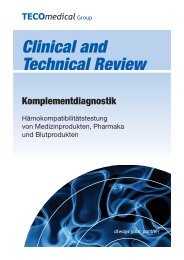
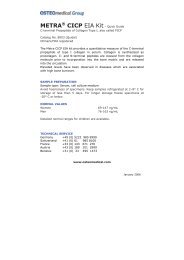
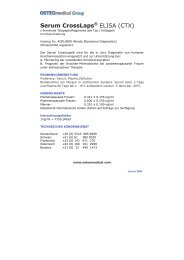
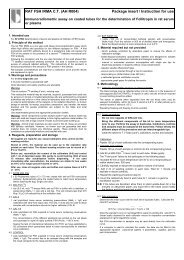


![PTH [Hormone Parathyroïdienne] Intacte ELISA](https://img.yumpu.com/1233682/1/190x245/pth-hormone-parathyroidienne-intacte-elisa.jpg?quality=85)
